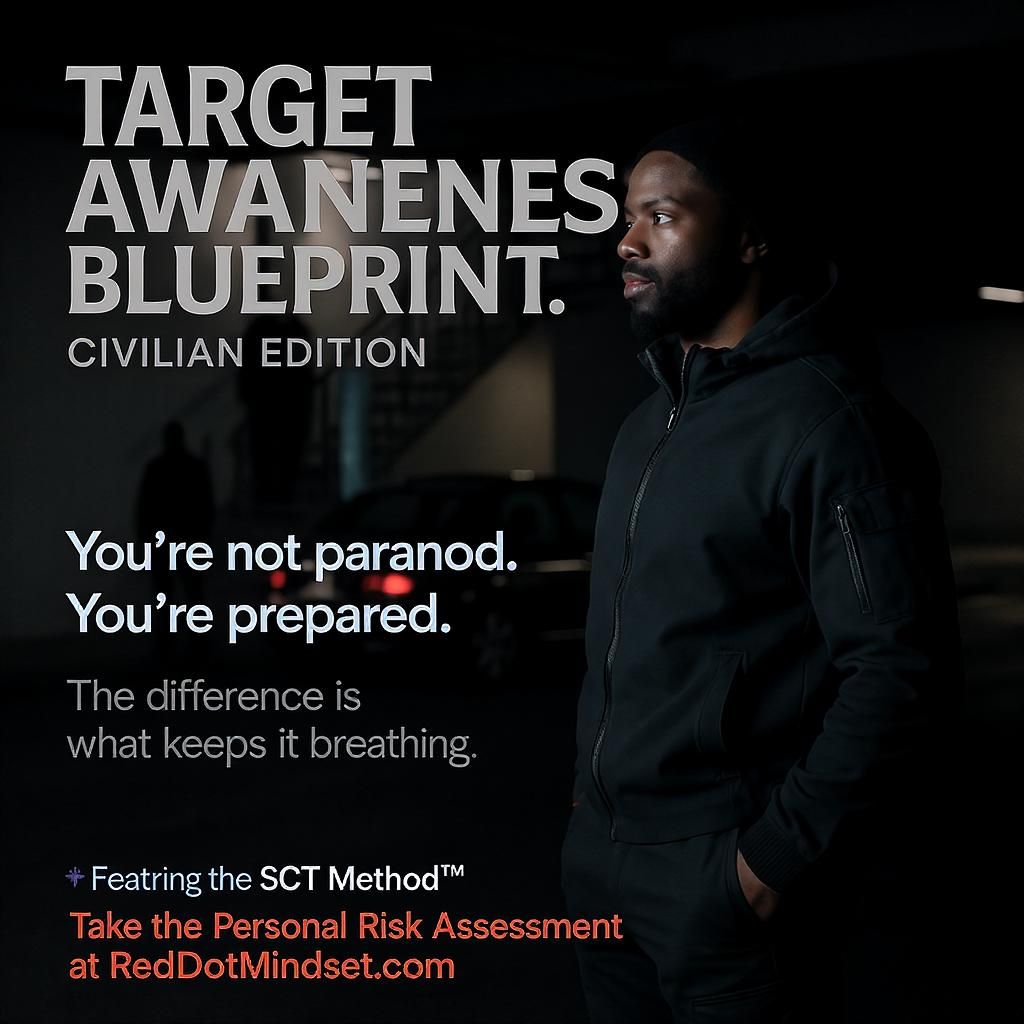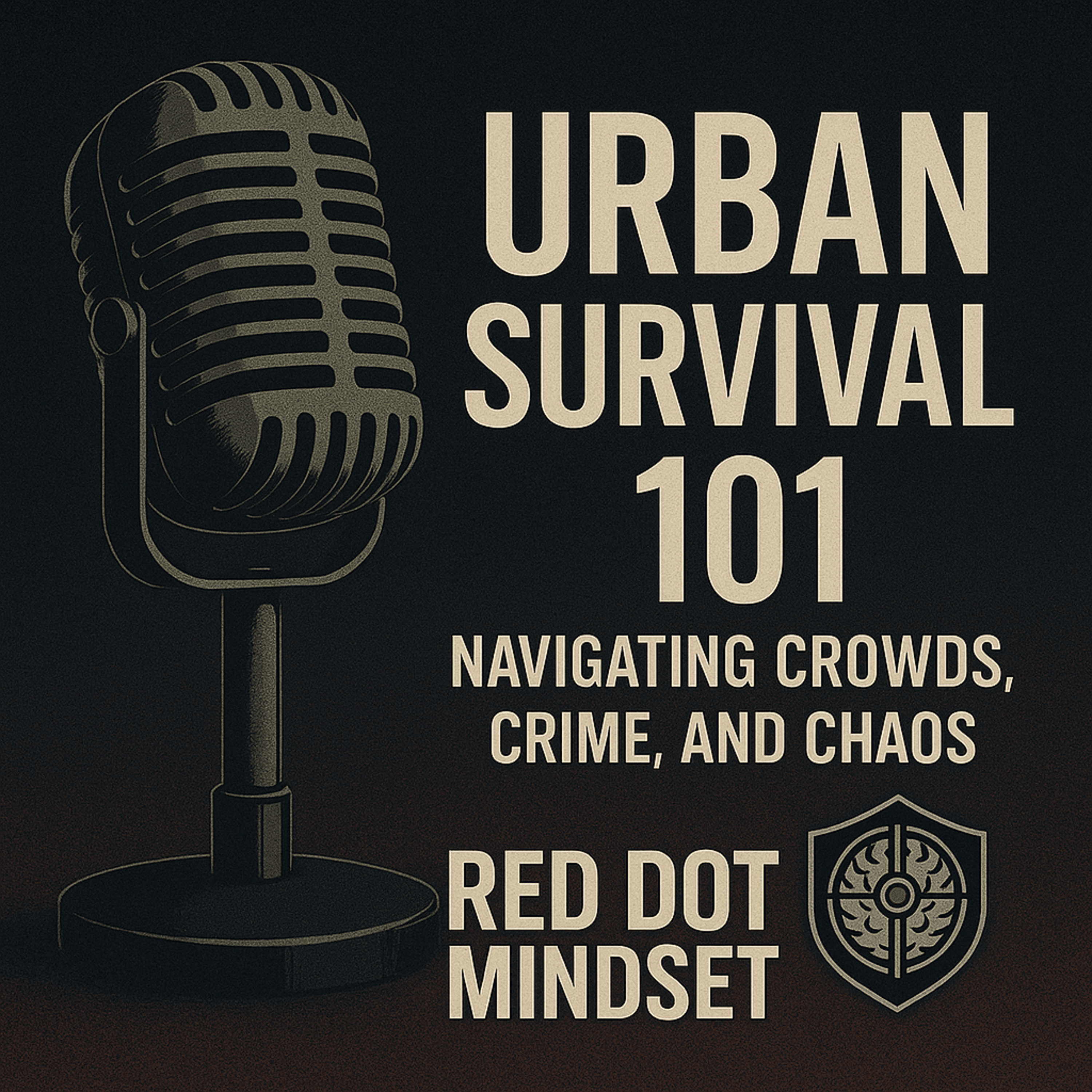Episode Transcript
[00:00:00] Speaker A: Welcome to the deep dive. Today we're really going to cut through some of the noise around personal safety.
[00:00:06] Speaker B: Yeah, there's a lot of misconception out there.
[00:00:08] Speaker A: Totally. Forget that whole idea that being mindful of your surroundings means you're like, paranoid. We want to shift that perspective.
[00:00:16] Speaker B: The crucial shift.
[00:00:17] Speaker A: You're not paranoid. You're prepared. And honestly, that difference, it's what keeps you breathing. This deep dive isn't about making you scared.
[00:00:25] Speaker B: No, not at all. It's about turning any apprehension into real practical readiness, actionable stuff.
[00:00:32] Speaker A: Exactly. And our guide for this is Mickey Midow. He's got an incredible background. 24 years USAF security pharmacist.
[00:00:40] Speaker B: Right. And he founded Gray Matter Opsa and created this system we're talking about, the target awareness blueprint.
[00:00:46] Speaker A: His whole mission seems geared towards us, towards civilians helping us operate. What did you call it? Left of bang.
[00:00:52] Speaker B: Yeah, left of bang. It's a tactical term. Basically means spotting and avoiding threats before they escalate. Before the bad thing happens.
[00:01:00] Speaker A: Okay. Left of bang. I like that. It's proactive, not reactive.
[00:01:04] Speaker B: Precisely. It puts you in control.
[00:01:05] Speaker A: So our mission today is simple. Take you on a practical, hopefully reassuring and genuinely empowering journey into everyday safety. We're focusing on mindset.
[00:01:15] Speaker B: Mindset over gear. That's key protection. Starts in your head.
[00:01:20] Speaker A: All right, let's dig in. Where does Mickey suggest we start?
[00:01:23] Speaker B: He starts with something foundational. A daily habit system called the SCT method.
[00:01:27] Speaker A: Sct?
[00:01:28] Speaker B: And it's designed to be simple, not some complicated military thing. Just something you can weave into your day to build awareness over time.
[00:01:35] Speaker A: Okay. Simple and habit forming. I like that. So break it down. S&SCT.
[00:01:39] Speaker B: S is for scan. Think of it as your like 60 second threat check. Whenever you walk into a new place.
[00:01:45] Speaker A: A coffee shop, grocery store, anywhere, anywhere anymore.
[00:01:48] Speaker B: And you're consciously looking for four things. Exits. Always know your way out.
[00:01:52] Speaker A: Okay, exits make sense.
[00:01:53] Speaker B: Then faces. What are people's expressions? Hands. Can you see them? And posture. Body language tells you a lot.
[00:02:00] Speaker A: Got it. Exits. Faces, Hands, posture. Just a quick scan to get a read on the environment and the people.
[00:02:06] Speaker B: Exactly. A rapid assessment.
[00:02:07] Speaker A: Okay, so I've scanned what's the C. C is counter.
[00:02:11] Speaker B: And this is interesting. It's about breaking your predictable patterns.
[00:02:15] Speaker A: Why is that important?
[00:02:16] Speaker B: Because predictability makes you vulnerable. An attacker looks for patterns they can exploit. If you always do the same thing, same time, same place, you become an easier target. Exactly. So counter is about making yourself unpredictable. Even small changes disrupt their planning. You essentially starve the threat.
[00:02:33] Speaker A: So the Example you gave earlier. If I always leave work at 5:15 and take the same highway entrance, right?
[00:02:39] Speaker B: Maybe one day this week. Leave at 5. Fine. 30.
[00:02:41] Speaker A: Yeah.
[00:02:42] Speaker B: Or take a different route home. Use a different gas station.
[00:02:44] Speaker A: Just one small change a week.
[00:02:46] Speaker B: That's the recommendation. Break one predictable pattern each week. It's about consistent subtle shifts, not overhauling your life.
[00:02:54] Speaker A: Okay, scan counter. What's the T?
[00:02:56] Speaker B: T is take action. This is about training yourself to move and decide under pressure. It's about avoiding that freeze response.
[00:03:04] Speaker A: Ah, freezing. That's huge, isn't it? That moment of paralysis can be so dangerous.
[00:03:08] Speaker B: It's. It really can. People often hesitate, right? They think, am I overreacting? Is it's really happening?
[00:03:14] Speaker A: Yeah. That's self doubt.
[00:03:15] Speaker B: Take action is about pushing past that. Making a decision, any decision really. To move, create distance, call for help. It's better than doing nothing.
[00:03:23] Speaker A: It's not about aggression, just decisiveness.
[00:03:25] Speaker B: Precisely. Being ready to respond, to protect yourself.
[00:03:28] Speaker A: So SCT scan, counter, take action. Practice it daily. That's the foundation before getting into anything deeper.
[00:03:35] Speaker B: Absolutely.
Build that habit first. Once that's becoming second nature, Mickey moves to the next layer. Understanding yourself as a potential target.
[00:03:42] Speaker A: Okay, this is the personal risk profile part, right?
[00:03:45] Speaker B: Turning that awareness inward. How might a threat actor see you?
[00:03:49] Speaker A: That sounds.
Yeah, a little confronting. But I get why it's necessary thinking like the threat to stay ahead of them. You mentioned this adapts Jonathan T. Gilliam's work.
[00:03:59] Speaker B: Exactly. It's not about fear. It's about self awareness. Knowing your potential vulnerabilities so you can address them. Mickey uses five key questions.
[00:04:07] Speaker A: Okay, let's go through them. Question one. Who are you to a threat?
[00:04:12] Speaker B: This makes you think.
Are you high profile, somehow emotionally valuable? Like someone might target you to hurt someone else. Financially vulnerable, legally exposed. What makes you stand out?
[00:04:24] Speaker A: And the drill is to actually score yourself.
[00:04:26] Speaker B: Yeah. Rate yourself today. One hardened to five exposed.
And identify one role. Maybe your job, maybe something public. You do that increases risk. That's the immediate action. And ongoing log new potential threats monthly. The knowledge check is can you actually explain what makes you a potential target?
[00:04:45] Speaker A: Okay, that's concrete. Question 2. What do you broadcast? This hits routines online and offline, right?
[00:04:51] Speaker B: Big time. Especially online. The drill.
Audit your last five social media posts. What do they reveal? Your schedule, your favorite places.
And then apply the counter principle again. Change one habit this week, commute, coffee shop, whatever. Immediately delete or privatize revealing online content weekly. Change a habit.
[00:05:09] Speaker A: And the check is. Can you name one vulnerability you just closed?
[00:05:12] Speaker B: Exactly. Connects Back to sct.
[00:05:14] Speaker A: Okay, third question. When are you exposed? This is about those transition moments.
[00:05:18] Speaker B: Spot on. Getting out of the car, gas pump, ATMs, stairwells, times when you're naturally distracted. Mickey calls them danger points.
[00:05:26] Speaker A: So what's the action here?
[00:05:28] Speaker B: List your top three transitions where you feel vulnerable. Then write a tiny plan, a micro response for each. Could be just scan first or adopt ready stance or be ready to reverse direction.
[00:05:40] Speaker A: Ready stance being feet shoulder width, balanced.
[00:05:43] Speaker B: Yep. The immediate task is identifying those three points.
Ongoing practice, one response weekly. Can you actually demonstrate a defensive posture right now? That's your check.
[00:05:53] Speaker A: Makes sense. Number four, where do you leave digital trails? This feels like a huge one today.
[00:05:59] Speaker B: Massive location, habits, personal life. It's often all out there.
[00:06:02] Speaker A: So, practical steps.
[00:06:03] Speaker B: Turn off photo geotagging. Seriously, make social profiles private. Really private. Use encrypted tools like Pro Con Drive for sensitive stuff. Do a full privacy check up now.
[00:06:13] Speaker A: And then maintain it.
[00:06:14] Speaker B: Audit settings monthly. This check, can you name one digital exposure you've now locked down?
[00:06:19] Speaker A: And Mickey has that friend security check idea too, right?
[00:06:22] Speaker B: Yeah, that's brilliant. Ask a trusted friend to Google you for 10 minutes, see what they find. Address, kids, school, work schedule.
[00:06:30] Speaker A: Wow. Whatever they find, a threat actor could find, too.
[00:06:34] Speaker B: Exactly. Then you lock it down. It cuts through your own blind spots.
[00:06:37] Speaker A: Okay, final question number five. How w could someone exploit you?
[00:06:41] Speaker B: This covers the methods. Impersonation, phishing, scams, those fake emergency calls, stalking.
Knowing the how helps you recognize it.
[00:06:52] Speaker A: And the drill for this.
[00:06:53] Speaker B: Google your cell's name and address. See what's public. The immediate action is lockdown or remove anything you're uncomfortable with. Repeat that search quarterly.
[00:07:02] Speaker A: And the knowledge check. Can you describe how you'd verify a stranger's identity if they approached you with some story?
[00:07:08] Speaker B: Right, right. It's a lot. But each step is actionable and builds on the others.
[00:07:12] Speaker A: Definitely feels empowering, not just scary. Okay, so you've done the SCT habit. You've assessed your risk profile. But what happens when something actually feels wrong? That gut feeling?
[00:07:22] Speaker B: That's where the threat response decision tree comes in. It helps you calibrate your response. Not everything requires dialing 911, but you shouldn't ignore things either.
[00:07:30] Speaker A: So it gives you levels. What's the first level?
[00:07:32] Speaker B: Suspicious.
You see the same weird car a few times. Someone seems to be watching you. Maybe it feels off, but not immediately dangerous.
[00:07:42] Speaker A: What's the action for suspicious?
[00:07:44] Speaker B: Log it, monitor it, take note mentally, or actually write it down. Maybe snap a discreet photo. If it's safe, don't dismiss it. But don't panic.
[00:07:52] Speaker A: What if it ramps up? Level 2?
[00:07:55] Speaker B: Concerning now, someone is actively following you or they confront you verbally. It feels intrusive.
[00:08:00] Speaker A: Deliberate action for concerning.
[00:08:02] Speaker B: Alert someone immediately. Text a friend, call family. Change your direction, create distance. Use those SCT skills. Scan for exits. Maybe change your path abruptly.
[00:08:10] Speaker A: Makes sense.
[00:08:11] Speaker B: And the highest level, threatening, aggressive behavior. Someone blocks your path. They display a weapon or you feel immediate danger.
[00:08:18] Speaker A: Action there is obvious.
[00:08:19] Speaker B: I hope crystal clear. Call 911 immediately. Move to safety. Get away. Your survival is the only priority.
[00:08:26] Speaker A: And this is where Mickey addresses that fear of overreacting. Right? The what if I'm wrong feeling.
[00:08:32] Speaker B: Yes. And it's so important. He stresses it is always better to overreact than underreact. Full stop.
[00:08:38] Speaker A: So calling 911 and being wrong is okay?
[00:08:41] Speaker B: It's more than okay. It's good training.
Law enforcement prefers a false alarm to arriving too late. It trains your brain to act decisively, not frees up second guessing yourself.
[00:08:52] Speaker A: That really reframes it. Okay, so we have awareness, habits, risk assessment, and a decision tree. What about tools? Does this require buying expensive gear?
[00:09:01] Speaker B: Not at all. To start, that's a core message. Focus on simple, budget friendly layers you can implement. Now. Mickey breaks it into three layers.
[00:09:08] Speaker A: Okay.
[00:09:08] Speaker B: Layer one, physical layer, simple stuff. A whistle, your phone's flashlight, app, legal pepper spray, usually around 20 bucks. Also, hardening your home. Better locks, lighting, and just walking with purpose makes you look less vulnerable.
[00:09:20] Speaker A: All right, physical layer two, digital layer.
[00:09:23] Speaker B: We touched on this phone. Privacy settings. Dive deep into those two factor authentication everywhere. Seriously do this?
Maybe try a free VPN trial. Use encrypted messaging. Lock down cloud storage, and do that.
[00:09:35] Speaker A: Quarterly friend security check you mentioned.
[00:09:37] Speaker B: Yep. Keep checking those digital doors. And layer three, behavioral layer.
Simple mantras. Say less, post less. Crucially, never follow a stranger to a second location, no matter the story.
[00:09:50] Speaker A: That's a hard rule.
[00:09:51] Speaker B: Absolutely. And practice refusal scripts. Just simple firm phrases like I'm not comfortable with that. Please step back. Having the words ready helps you use them.
[00:10:00] Speaker A: Okay, so for these layers, physical, digital, behavioral.
What's the immediate step?
[00:10:05] Speaker B: Pick one thing today.
Set up one tool, change one setting, ongoing habit. Test your layers monthly. Check your spray, review privacy settings and the check. Can you explain your system to someone else?
[00:10:17] Speaker A: Builds confidence layer by layer. Love it. How do you make this sustainable? It feels like a lot to remember.
[00:10:23] Speaker B: Consistency is everything. That's how you become a hard target.
[00:10:26] Speaker A: Mickey suggests a monthly readiness plan.
[00:10:28] Speaker B: Okay, what does that look like? Weekly practice, one small drill, maybe a threat Scan when you're out. Varying your route. One day, do a quick social media check. Just one thing manageable.
[00:10:40] Speaker A: Monthly.
[00:10:40] Speaker B: Go a bit deeper. Review your risk profile. Has anything changed? Test a refusal script out loud. Run a tiny family micro drill. Like, hey, if we got separated in this store, where would we meet?
[00:10:51] Speaker A: Small practical conversations.
[00:10:52] Speaker B: Exactly. And quarterly, do the friend security check and maybe visualize or walk through a scenario. What would you do if confronted? In a parking lot?
[00:11:03] Speaker A: Yeah.
[00:11:04] Speaker B: In your home. Making it more ingrained.
[00:11:06] Speaker A: Immediate action. Pick one drill this week. Ongoing log. Your monthly actions. Ultimate check. Can you teach this method to someone else?
[00:11:13] Speaker B: That's the goal. Make it second nature. And it works. Let's talk about Sarah's story.
[00:11:17] Speaker A: Right. The teacher. This makes it real.
[00:11:19] Speaker B: So Sarah starts getting threatening emails from a parent. Scary situation, right?
[00:11:23] Speaker A: Very. How did she use the blueprint?
[00:11:25] Speaker B: First, she assessed her risk, scored herself a forwarder job. The direct threat. Yeah. She felt exposed, then she acted.
[00:11:32] Speaker A: What did she do?
[00:11:33] Speaker B: She immediately started varying her route home from school. That's counter. She scrubbed her school info from social media, addressing the what and where questions. And she briefed her principal, alerting someone.
[00:11:45] Speaker A: Proactive steps. Did it help?
[00:11:48] Speaker B: Two weeks later, she's near her gym and she spots the parents car. Because she'd been practicing scan. She'd assessed her risk. She recognized it wasn't random.
[00:11:56] Speaker A: So she didn't dismiss it.
[00:11:57] Speaker B: Nope. Her training kicked in. She immediately called the police. The framework let her identify and avoid a real escalating threat before it reached her. It wasn't luck. It was preparation.
[00:12:09] Speaker A: Wow, that's powerful. Really shows the left of bang concept in action.
[00:12:14] Speaker B: Absolutely. Train the mind, win the fight. And that training should include your family. Right. Safety is a team sport.
[00:12:20] Speaker A: Definitely. But how do you bring this up with, say, your spouse or teenagers or even elderly parents without freaking them out?
[00:12:28] Speaker B: You normalize it. Frame it like any other preparation. Like fire drills, like updating passwords. It's just responsible living.
[00:12:35] Speaker A: So maybe start with something like you.
[00:12:37] Speaker B: Could say, hey, this isn't about being scared. It's just about having a plan. Like, we have a fire extinguisher, or you know, how we update software? Let's update our awareness. Awareness a bit too.
[00:12:47] Speaker A: Keep it calm, practical about readiness, not danger.
[00:12:51] Speaker B: Exactly. Making safety just another part of being smart and confident.
[00:12:54] Speaker A: This whole conversation has been incredibly insightful. It really does flip the script from worrying reactively to preparing proactively.
[00:13:02] Speaker B: That's the goal. And it circles back to that core idea. You are the target until you make yourself a hard one.
[00:13:09] Speaker A: Train deliberately respond with confidence.
[00:13:12] Speaker B: That's it.
[00:13:13] Speaker A: If this conversation helped you reframe your own safety mindset, maybe sparked some ideas, we really invite you to go deeper. Head over to red.mindset.com yeah, check it out. They have a free five minute personal risk assessment you can take right now. It'll give you a customized 30 day action plan to start hardening your daily life.
[00:13:30] Speaker B: And it's all based on this blueprint. No fear, no expensive gear needed, just focusing on your mindset.
[00:13:36] Speaker A: That's red.mindset.com home of the Target Awareness Blueprint, the SCT method, and all this practical tactical mindset training for everyday folks like us.
[00:13:45] Speaker B: Red mindset. Com Good stuff there.
[00:13:47] Speaker A: Train the mind, win the fight, stay alert, stay adaptive, and stay gray.




